#bbc les mis
hey yo les mis fandom,,, has there been literally any update on bbc les mis in the past like year??? cause my every-few-months google search tends to just pull up the same two year old articles, but i was wondering if the fandom found any other info
Episode 4 has lots of little scenes cut that flesh out Marius’ life a bit more - there’s a notable scene with Courfeyrac that was cut which gives him Bossuet’s lecture backstory from the Brick, and Éponine has more dialogue in many of her scenes.
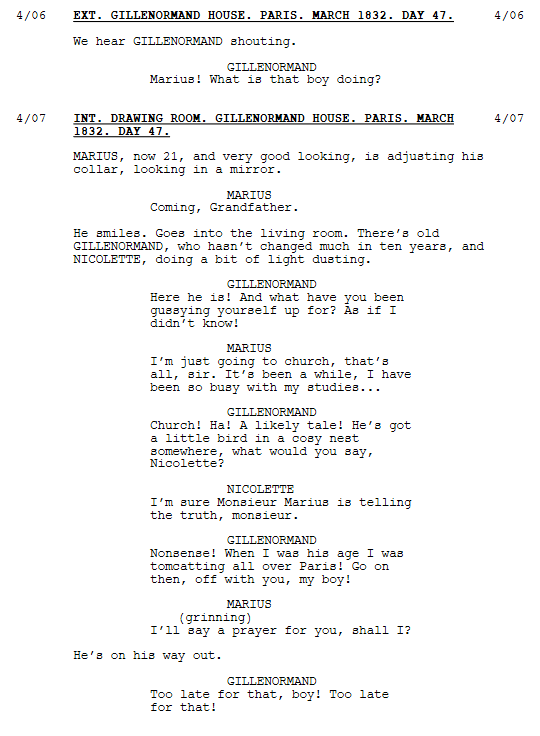
These short scenes aren’t found in the broadcast episode - they come right before we see Marius encounter Mabeuf in the church for the first time to hear the truth about his father at last.

These scenes are also missing from the episode as we saw it, which instead leads us right from Marius’ conversation with Mabeuf to the scene where Marius bursts in on Gillenormand and confronts him about it.

Another cut scene that gives us more Courfeyrac, who gets Bossuet’s backstory with Marius while at the same time managing not get expelled from his studies for it.


This encounter with Patron-Minette is missing from the episode as well, as is Marius’ conversation with Courfeyrac which fleshes him out a little more



While this scene did make it into the episode, much of the early parts of this conversation here didn’t. While Valjean does tell Cosette reluctantly about her mother, the episode misses much of the details he gives here.

Missing from the episode is also this encounter with Patron-Minette on Valjean and Cosette’s first outing to the Luxembourg.

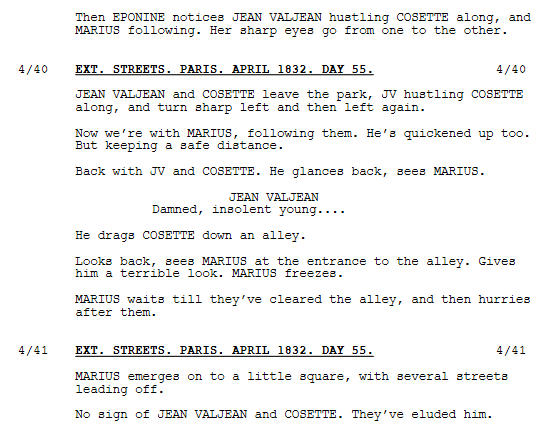
This scene ends much earlier in the episode we saw, ending with Valjean declaring it too chilly. It’s missing Valjean’s paranoia and anger at Marius following them - on TV, Marius loses sight of them while they leave the park and never follows them through the streets.


Also missing is this scene between Marius and Eponine following Marius’ return from the Luxembourg.

Marius’s dream starts somewhat differently - in the show, Cosette enters his bedroom.

This scene plays out on screen much as it does in the script, but there is a lovely bit of Valjean characterization in the script, and we unfortunately don’t get to hear the convicts sing.



About half of the dialogue is missing in the version we saw, including Eponine showing that she can read and her speech about sleeping under the bridges and what it feels like to starve.

Also most of the dialogue from the end of this scene is missing.

This very short scene where Cosette remembers the Gorbeau house on their visit to the Thénardiers is missing as well.

The visit to the Gorbeau house plays out as it is in the script, but I’m enjoying this scene description too much not to quote it. :D

While this scene mostly plays out on screen as it does in the script, we are unfortunately missing out on this utterly delightful ending where Javert disdainfully refuses to shake Marius’ hand.

Also cut is this short moment of Marius cocking his pistols and nearly giving himself away.

Missing from the script, for a change, is the tense ending to this scene we saw on TV where Javert looks out of the window for long moments with Valjean clinging to the outside wall only a few centimeters away from him.
Episode 3 brings us several additional scenes and details, mostly fleshing out the Thénardiers a bit more, giving us Santa!Valjean, but also giving Catherine the doll a surprising cameo that was cut.


While the episode opens straightaway with Champmathieu before the judge, the script has additional scenes before that which show Valjean with the court usher.

In the script, Champmathieu’s speech is longer and gives us more Brick details about his background and his daughter.

Instead of Javert’s very memorable “CUFFS!” moment on screen, the script is a bit more laid-back here.

In the show, we see Valjean retrieve a file he’d hidden in his mouth in this scene to show us that he’s planning to escape, and to lead us towards his next scene where we see him free in the forest. In the script, there is no file. Instead he gets to have an emotional moment with the little bird Fantine made - which also leads us to Cosette and the promise he made, but perhaps, without the Orion, makes his transition from prisoner to escaped convict too confusing.
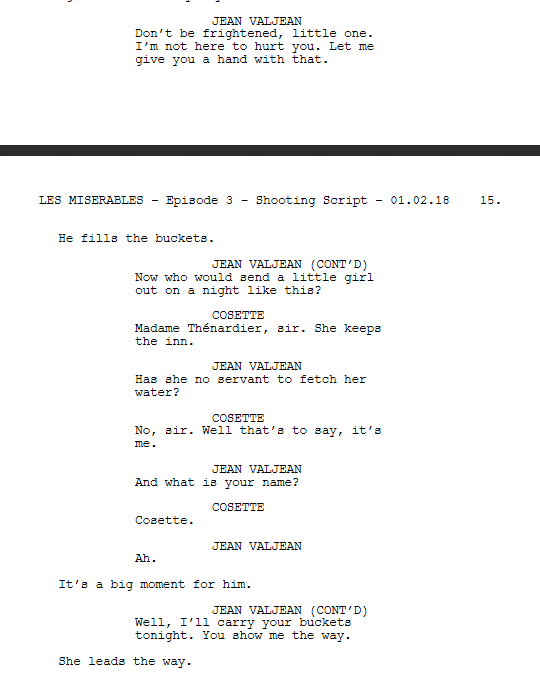
Valjean’s first conversation with Cosette is somewhat longer in the script here, where he asks her about the Thénardiers and their treatment of her.

This short conversation between the Thénardiers discussing Valjean is cut entirely.
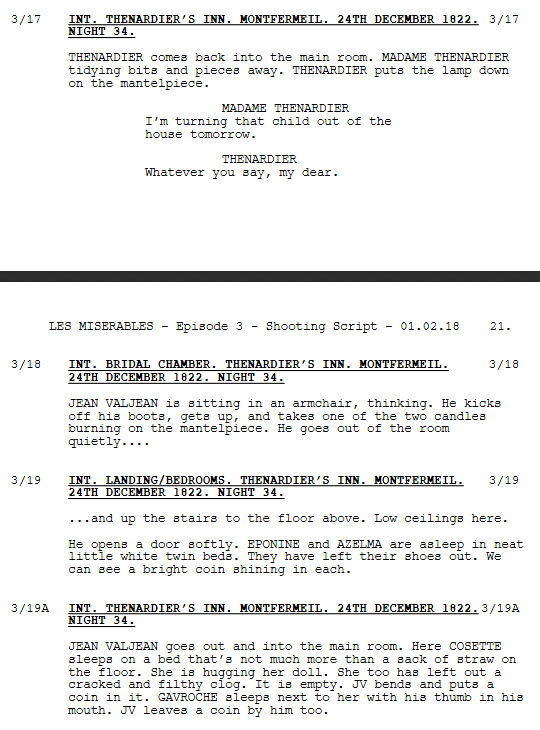
Also in the script but not in the episode we saw are a few further Brick details, like Madame Thénardier deciding to throw Cosette out and Jean Valjean playing Santa by leaving a coin of gold in her shoe (and, unlike in the Brick, in Gavroche’s as well).

Furthermore Valjean and Cosette’s conversation after they leave the inn is longer in the script; Valjean explanation about Fantine’s death and Cosette asking if he is her father aren’t in the broadcast version.

This scene plays out on screen as it does in the script for the most part, except that we’re missing the running gag of Javert staying at the Wild Duck, just like Madame Victurnien did (and everyone else who’s warned by their coachman about the Thénardiers).
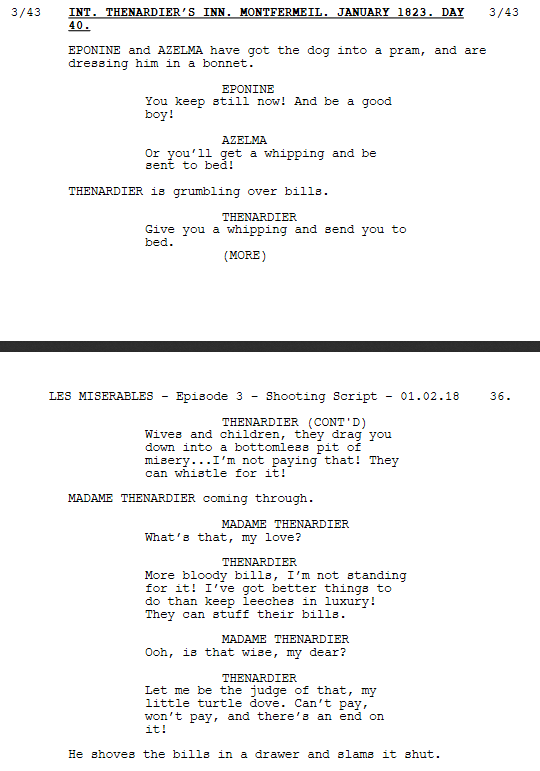
The broadcast episode misses this entire scene with the Thénardiers that prepares us for their coming bankruptcy.

Also missing from the actual episode is this scene with its nod to Javert disguised as the Gorbeau beggar.


This scene has some additional dialogue in the script that seems to place more of an emphasis on Javert’s part in it.

Also missing from the show is this scene of Valjean and Cosette running from the police after they escape the Gorbeau tenement.

The only part of this scene that made it into the show is Cosette complaining about her hurting feet, which unfortunately means that we are denied a Valjean who’s seeing visions of Javert’s smiling face.
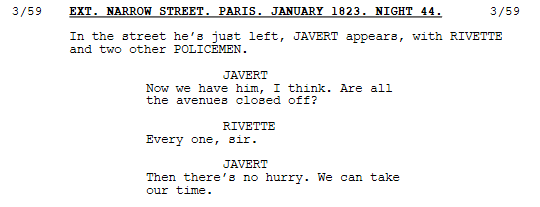
Unfortunately also absent from the episode is this moment of Javert savouring his game just as he does in the Brick.
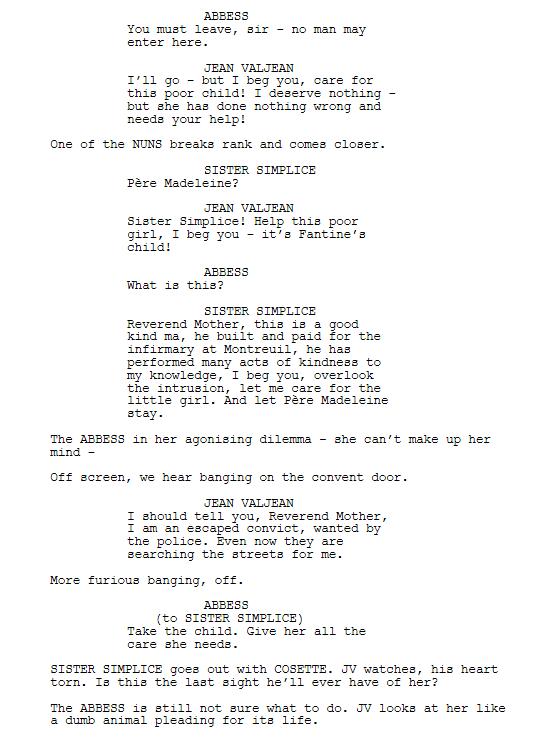
This scene mostly plays out as it does on screen, although both Valjean’s and Simplice’s dialogue is longer, but I am mostly just awwing over the description of Valjean looking like a dumb animal pleading for its life. The best convent Valjean.

The final scene of episode 3 brings us one final change from script to screen: instead of overturning the bed in rage, Javert seems more of a Disney villain here as he keeps stomping on poor Catherine the doll. Nevertheless, as glad as I am that TV Javert got to keep his dignity, I enjoy the description of Javert looking at the doll “as if it were a precious icon,” underlining the fact that the pursuit of Valjean has turned into a nearly religious act for him.
Cut scenes, additional dialogue and details of interest for episode 2:
The conversation between Fantine and the Thénardiers is longer in the script - there’s some additional detail here about Cosette’s beautiful clothes which the Thénardiers are of course eager to claim.



This long, delightful scene from the Brick is unfortunately missing in the episode we saw - I assume it was cut for length which is a shame, because I enjoy the way it both fleshes out Fantine’s Montreuil grisette friends and gives us the Brick scene about Madeleine’s “grotto” and the town’s gossip about it, which never makes it into adaptations.

Also missing from the episode: this heartbreaking scene showing that the Thénardiers keep Cosette in the kennel with the dog, perhaps in a nod to this bit from the Brick: “Éponine and Azelma did not look at Cosette. She was the same as a dog to them.”

We see this scene play out pretty much the same on screen, but the script confirms what the actors have told us in interviews: both recognize each other from the start in this scene.

Plus we get this additional explanation from Javert about what sort of town Montreuil is, presumably cut for length or because it interferes with the tension of this game of double meanings they both know Javert is playing.


My favourite find in this episode: An entire cut scene in which Javert converses with Police OC Basquiat, who at first glance seems to fulfill the function of giving us more exposition about the good Madeleine has done for the town, but at second glance seems to ship Javert with Madeleine.

Also cut was this scene with Sister Simplice that foreshadows what is to come.

Madame Victurnien’s visit to Montreuil has a bit more dialogue here, plus details about the wine she’s served.

This scene also has some additional dialogue in the script for Javert that we don’t get to see, although the scene has tension enough without Javert having to spell it out like that.

Another scene missing is this little interlude at Laffitte, where, curiously, Valjean only withdraws 70 000 instead of 630 000 francs.

Just as curious is that while the script had Javert on a horse in Toulon, we see him walk in Montreuil and in Paris here - compared to the broadcast episodes where Javert walks in Toulon, but is set above others on the scene as he rides his horse both in Montreuil and on this ride to Paris, where he gallops up to the Prefecture in a rather spectacular fashion.
More historically accurate, of course, Javert would have taken a coach to Paris, but I for one enjoy the visual of Javert racing up to the Prefecture too much to want to argue with this decision.

In the show, this scene takes place at night, and Valjean and Javert encounter each other on horseback - no cronies, only horses.

There is some additional interaction here - a named OC called Marguerite who doesn’t have any lines in the broadcast version of the Bamatabois scene.

This part of Javert’s speech was partly cut, perhaps because method actor David “Javert” Oyelowo realized that talking about Valjean’s wise and kind features is a bit too much even when he’s playing with him.

There is some additional information here that the episode as broadcast doesn’t give us, namely the fact that Javert (or so he claims) has already been visiting Champmathieu in Arras.


This part of the script is of especial interest to me because the show’s most visceral part of Valjean’s dark night of the soul - when Valjean takes the burning coin out of the fire with his bare hand and intentionally burns his palm with it - seems to be entirely unscripted. Perhaps a very late addition or improvisation - although the latter seems unlikely, given that there surely have to be some sort of special effects or a stuntman involved.
Onward to episode 3 tomorrow.
Changes, missing scenes and additional interesting details I found comparing the shooting script to the show we got to see. I’m trying to do one episode per post, which means this posts will be rather long. I’m hoping to do one episode per day.


Exposition that did not end up in the TV cut, featuring a visiting cardinal high up above the convicts (recalling the scene in the Brick where Valjean sees a visiting bishop from afar) as well as Javert’s Thoughts on Crime and Jean Valjean in Particular. Furthermore this is quite a change from the rock scene we got to see on screen.



In the script of the interrogation scene, Valjean speaks - the stony silence we see in this scene during the broadcast episode is a far more effective choice than this rather awkward repeated “No answer,” of course.
The script also names one of the Toulon OCs here: Gambon the guard.
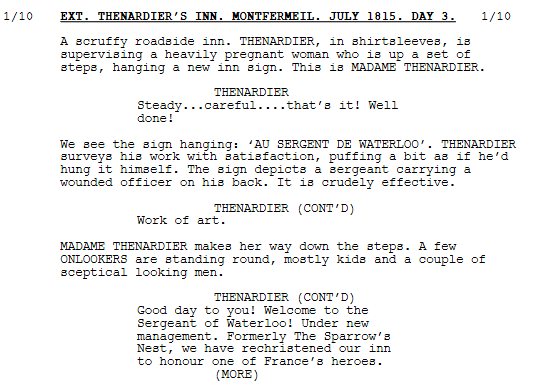
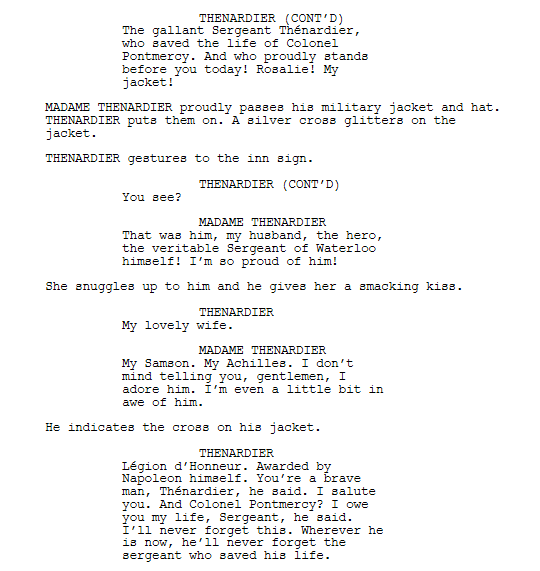
Thénardier backstory for the inn in Montfermeil we did not get to see in the show.


Gillenormand/Nicolette in the shooting script, which did not make its way onto the screen - a scene that seems to take the place of Gillenormand’s glee at being accused of having fathered his former servant Magnon’s children.

Javert was suposed to ride a horse both in his first scene with the cardinal as well as in his later scene guarding the quarry.
The way the final cut sees him progress from standing on his feet and walking in the dusty heat of Toulon to riding his horse through the streets of Montreuil seems indeed a better visual representation of his rise.
Furthermore, in the episode we saw this attack of a prisoner on a guard leading to the execution scene didn’t happen in the quarry but while the prisoners moved through Toulon.
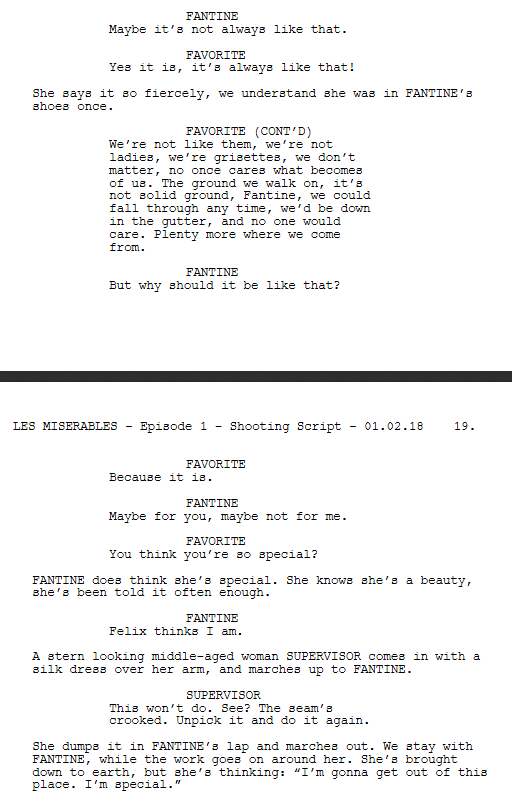
Fantine’s conversation with Favorite is longer than what we see on the screen - the shooting script puts a lot more emphasis on her thinking that she’s special, which the final cut lacks.

Felix talking with his friends about their coming abandonment of their girlfriends only exists in the script and is missing from the episode.

Also missing is this following scene of Fantine at her former job, still secure in her current happiness, not realizing that she’s only days away from losing all security.
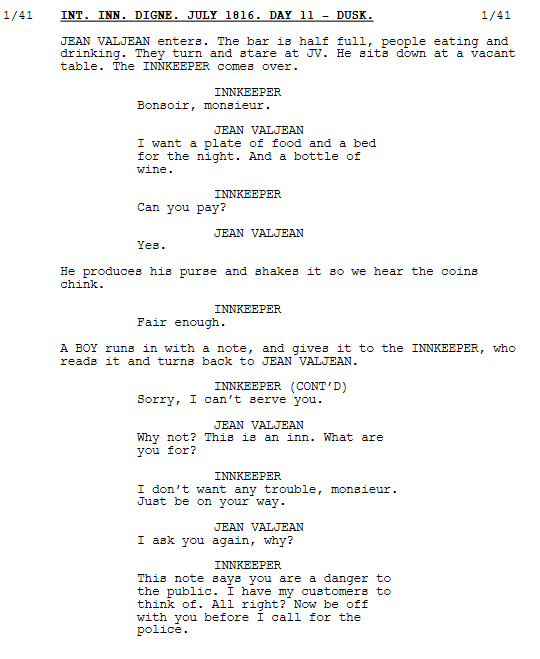

This scene showing us Valjean trying to spend the night in an inn after being released from Toulon also did not make it into the final cut.
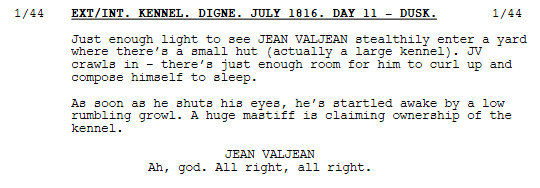
Also originally in the script and not in the final cut, the Brick scene in which Valjean tries to sleep in the dog’s hut.

Additional Bishop feelings in this scene, the end of which did not make it onto TV.

After being released by the Bishop and leaving with his candlesticks, Valjean has a flashback to his childhood and his mother which isn’t in the final cut.
Episode 2 to follow hopefully tomorrow.
I wasn’t exactly blown away by the costumes in the BBC production of Les Mis, and Cosette’s in particular, cute as Ellie Bamber is, were thoroughly “just okay.” But I didn’t put much more thought into it…
Well, not until Gentleman Jack–set in the exact same time period–blew BBC’s Les Mis out of the water with its costume design. Then more recently, when I started researching the fashion of the early 1830s, all the ways in which poor Cosette’s costumes fell short became glaringly obvious.
Disclaimer: I am not as much of a stickler for historical accuracy in period drama costumes as this little essay is going to make me out as being. I’m not a Frock Flicks kind of gal; I just want to be entertained and look at pretty clothes. So as far as I’m concerned, as long as the basic silhouettes are there and the costumes are nice to look at, I’m there. (I find the wildly inaccurate costumes of The Tudors a lotmore visually appealing than the ones in Wolf Hall. And everyone knows Sofia Coppola’s Marie Antoinette was highly stylized, but those costumes are to die for and still embody the rococoaesthetic very well.)
That said, Cosette is a character who’s very invested in fashion, and the general look of the 1830s isn’t unknown to English productions, being the setting of Queen Victoria’s adolescence, Jane Eyre,Wives and Daughters, and many a Dickens adaptation among others.
So where did they go wrong?
Being honest, most of the Les Mis productions from the past two decades or so failed to put Cosette in high-fashion or even noteworthy costumes. Only the 2012 film for all the ways it failed her as a character hit it out of the park. Cosette gowns were damn near perfect–and they were actually pretty to boot! Unfortunately in the actual film you can’t evensee the floral gown and you can barely see the blue one…thanks Tom Hooper.
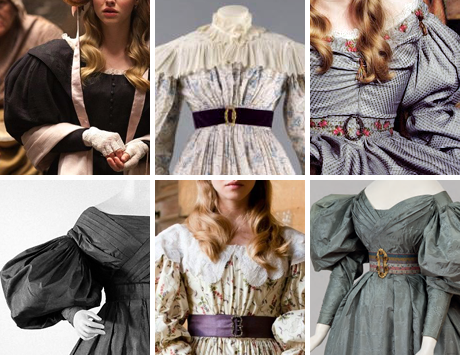
The belts/buckles, the enormous sleeves, the delicate floral prints and embroidery, the lace collars…pat the costume designer on the back! (Her wedding dress was also on-point, but we’ll get to that.)
Claire Danes and Virginie Ledoyen had passable-and-sometimes-good costumes, too. Though Claire Danes’ were generally not very pretty, their overall silhouette was correct. Virginie Ledoyen gets a couple of knock-out, very period-appropriate gowns; the rest sort of fall into the nebulous “well, I guess you tried” category without being unattractive.
But the BBC production just…dropped the ball for reasons unknown.
Now, in the book Cosette overhears some ladies calling her “pretty but badly dressed.” She’s shocked, because she thinks she’s ugly but well-dressed. She then goes on a charming quest to become the best-dressed woman in Paris, and the BBC adaptation even has a scene where she goes to the seamstress. It’s really cute. Too bad that the dresses are…really not.
Here are some fashion plates from 1830-32. Keep in mind that Cosette lives in Paris, of all places; she would be aware of what was and was not fashionable.

This is the height of Romantic fashion: giant (“gigot”) sleeves and bonnets, full skirts with hems at or just above the ankle, lace accents, silk stockings and slippers, elaborate hairdos. The 2012 costumes, again, capture this quite well.
And even if the BBC designer had taken liberties and had fun while preserving the overall aesthetic–think what Sandy Powell did in Cinderella, set in roughly the same period–I wouldn’t be making this post. But there’s curiously little 1830s to be found in Cosette’s wardrobe at all.
I guess we should start with the BBC’s Good/Accurate Stuff. This coat Cosette wears is, apart from the deep fur-lined V-neck, almost a carbon copy of the extant coat on the right. And she has a bonnet!
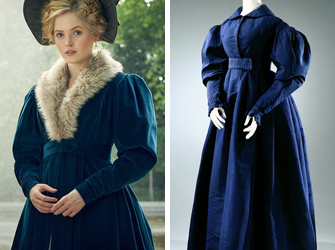
Cosette’s best/most accurate dress is, naturally, the most difficult to see and has the least screentime of all her costumes:

From what I can tell, the sleeves, though delicate and sheer, are very full, as is the skirt, and the whole thing seems both pretty and en vogue…despite the questionable neckline. It’s also detailed–embroidery on the sleeves and with pleats (?) to create visual interest at the shoulders and on the bodice!
Here are a selection of other short-sleeved gowns from the period for comparison (both extant garments and costumes/reconstructions).

Tbh Ellie’s costume should be as stunning as the blue gown (far left) that an extrawore in Cinderella, but…maybe someday, in some Les Mis production, that gorgeous Sandy Powell creation will reappear.*sigh* (Virginie Ledoyen’s best Cosette gown is on the far right, btw.)
Anyway, that’s…that’s about it for the “Good” category.
Next up: her teal/turquoise dress(es). (She also wears a red one that looks exactly like this.)
Someone didn’t tell the costume designer that Cosette was supposed to be a fashionista, I guess. During my research, I did find a couple of dresses that resembled these two…but they would both be several years out of date by the time Cosette was going on her fashion crusade:

Even the yellow dotted dress has more style and “oomph” than what poor Cosette got stuck in–her sleeves look comparatively small, deflated, and underwhelming, all the more so when compared to actual1830s gigot sleeves.
In the interest of being fair, some extant gowns from the right dates also look somewhat like these two.

But they all look, well…better. They all make me wish Cosette’s gown had bigger sleeves, a more-defined neckline, less wrinkly fabric…anything that would take it up a notch. (Also of note: as plain as some of these dresses look, they would not have been worn alone–accessories like wide belts, shawls, bonnets, etc., would have been part of the outfit when they were actually worn.)
And when it comes down to it, Cosette–who wants, after all, to be wearing the most fashionable gowns, like those in the fashion plates–should be wearing gowns more like…

The detailing, the fabric choices, the tailoring, and (sorry) the size and position of the sleeves makes all the difference here. A little more effort, even just padding for Cosette’s poor limp sleeves and a belt, would be enough to bump her looks from “kind of sad” to “something I believe this character would really wear.”
My personal favorite gown in the production was very pretty, flowing and delicate–and look: I’m willing to accept that Cosette wouldn’t always be wearing a fashion plate while chasing butterflies (something no film Cosette has, tragically, ever done…) That said, it still wasn’t very 1830s.
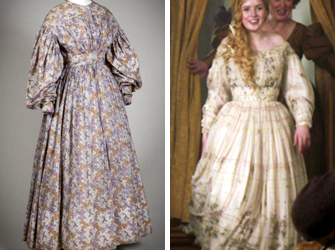
This purplish gown is the closest extant I could find to something like what Cosette wears here, but once you look at the details of both–fabric, neckline, whatever is happening around waist–all you get is “???” A lovely dress, but one that doesn’t make much sense.
So finally we come to what ought to be the showiest of all Cosette’s costumes: her wedding gown.
This costume ought to be Stunning for a lot of reasons. The “Fauchelevents” have money! The Pontmercys have money, and they have society friends! Cosette is a fashionista, and she’s head-over-heels in sweet young love! And one an assume that Valjean wants to send off the light of his life, if send her off he must, in style–he’s heartbroken but also knows, from this moment, that he will never have to worry about her safety or well-being again.
With all that in mind, this is what Ellie’s Cosette wears…
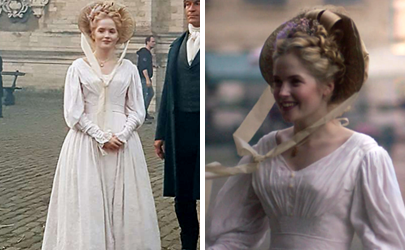
Oh. Okay. Is it her freaking wedding day, or is she just going to a church picnic???
At least she IS wearing a bonnet in this scene, but it’s the same color as her hair (?!) and it’s tiny…just like her sad, deflated sleeves. The necklime and waistline both are at least accurate here, but like the sleeves, the skirt isn’t voluminous. Not a single thing about the dress makes a statement…unless it’s a shrug. The impression is, once again, “meh?”
At least a veil (which some women did wear on their wedding bonnets) would emphasize the “wedding day” vibe. How about, if they weren’t going to give it any volume, some detail on the gown…anydetail…floral embroidery…a BELT…a contrasting color or fabric (lace, hello?!)…anything??? It’s just so plain and low-key.Just like everything Cosette wears in this miniseries.
Here are some period wedding gowns, two of which Cosette wears in other adaptations. They all have the wow factor this dress lacks.

Big sleeves! Lace! Belts! Veils! Lush fabric! Frills! Different colors/fabrics to create visual interest! Hairstyles that pop instead of blend together! These are the kind of gowns that say “I’m the bride and this is my day.” Not “I’m going to the church picnic.”
I want to reiterate that, after ALL that rambling…my big issues are that a) these dresses are not–by and large–attractive or interesting and b) that they fail to embody Cosette’s love of fashion. The fact that they’re so inaccurate for the time period is secondary. However, paying more attention to the fashions of 1830-32 would, I think, have helped make the costumes prettier andmore suited to the character. How you dress a character is also a factor in how their character is perceived and can be a subtle means of character development. No chance of that here. (Post-marriage, Cosette wears such a blase dark blue coat that, sans fur trim, looks identical to her previous one. Yawn.)
I’m just a fan, yet it still took me only three days of basic research to put this post together. Expecting a costume designer to put in at least a few days of light research is not a huge leap. I’m going to venture a guess and say that this designer did not bother to do that. And it shows.
It’s a shame, because Cosette gets a lot more screentime here–for the first time since the 2000 production–and she deserves so much more than shapeless gowns and barely-styled hair.
And also more than Andrew Davies…but that’s a rant for another time.


